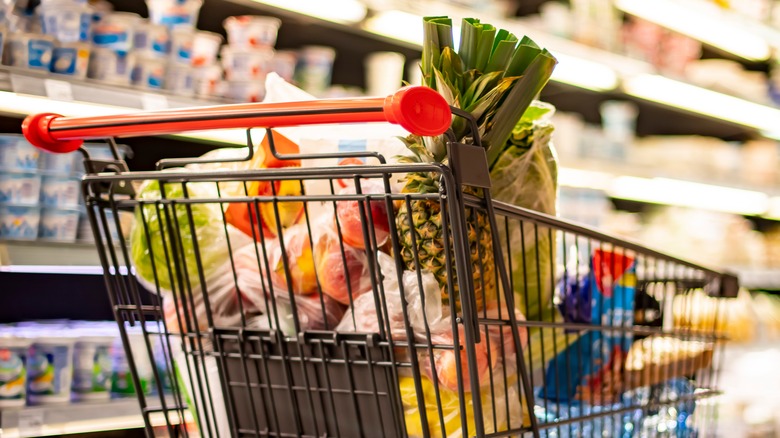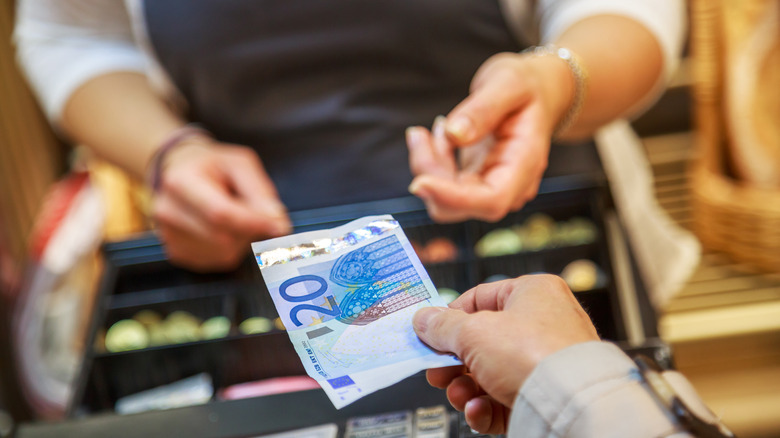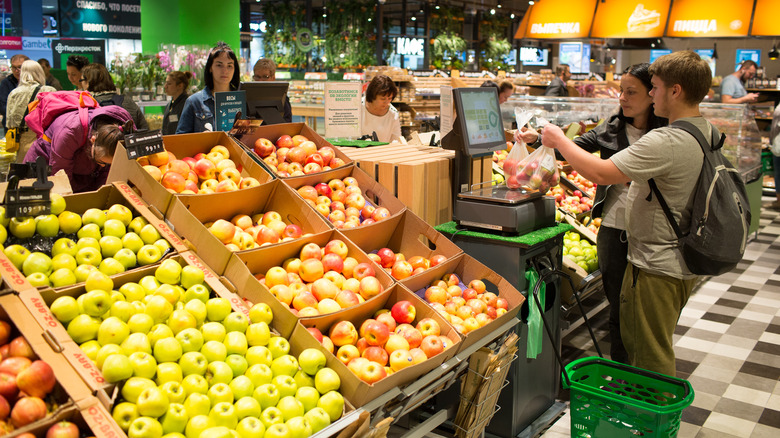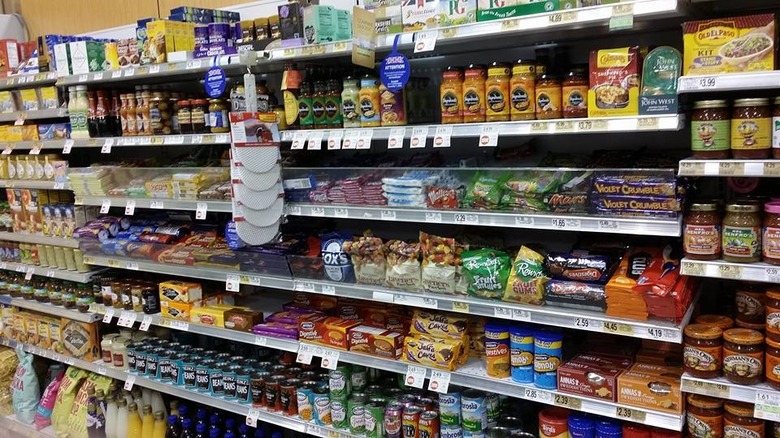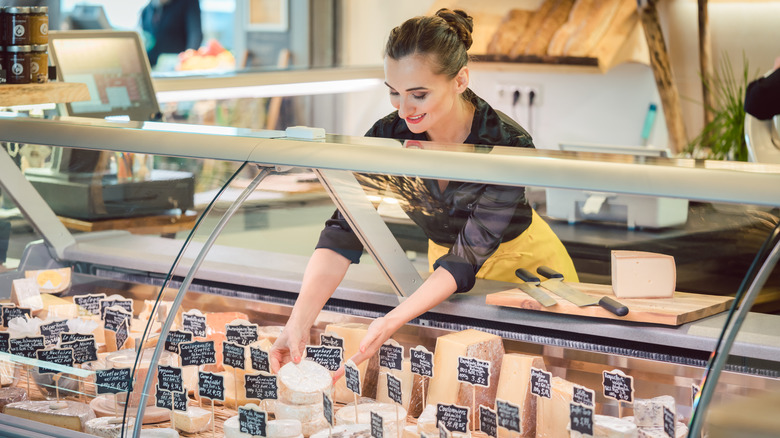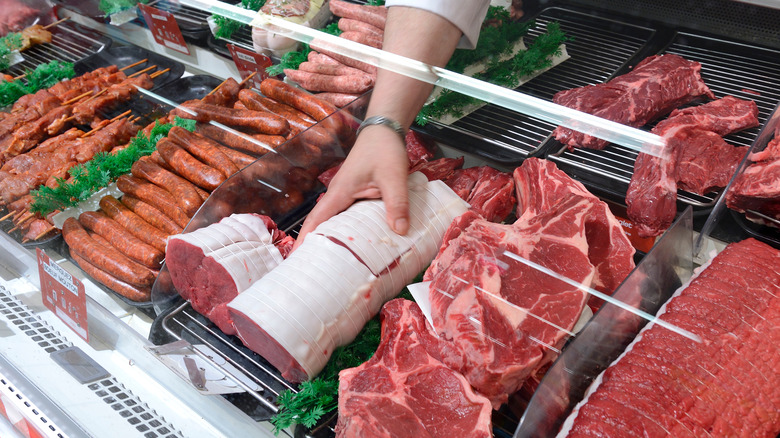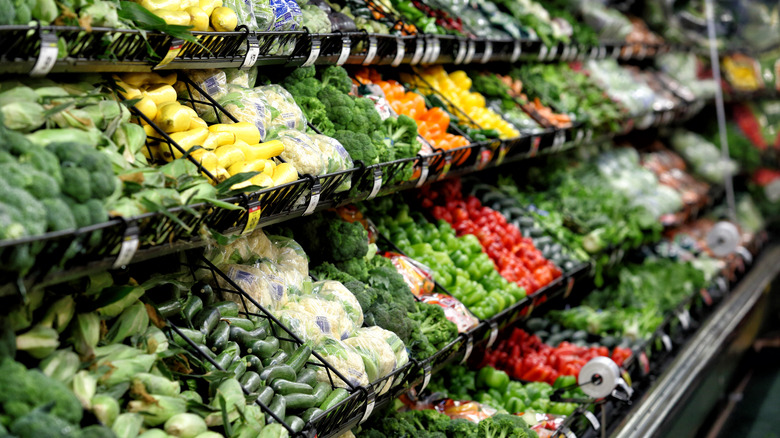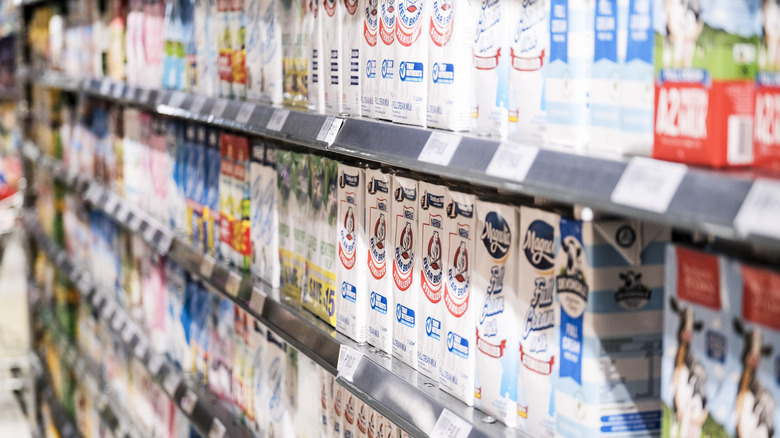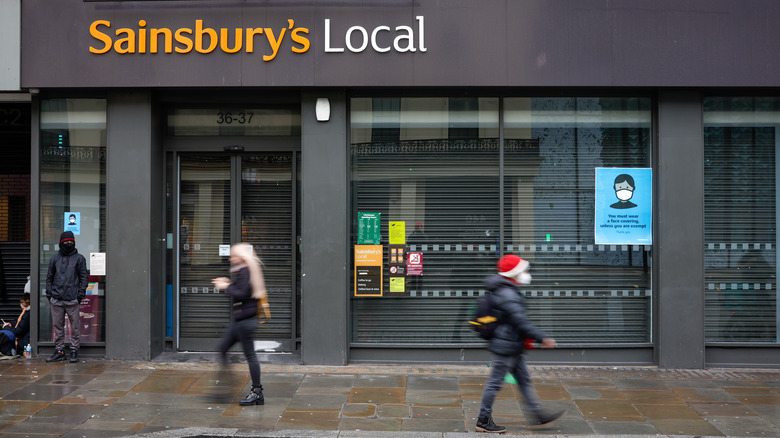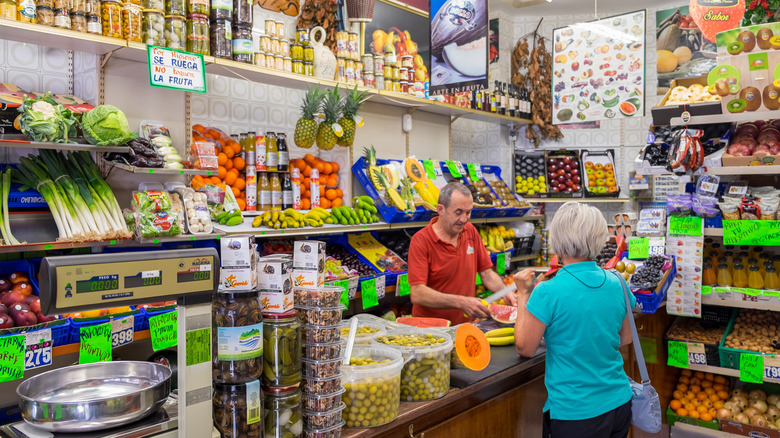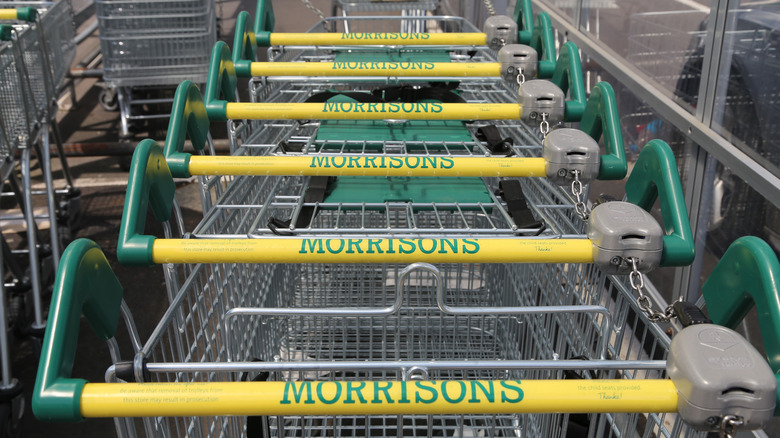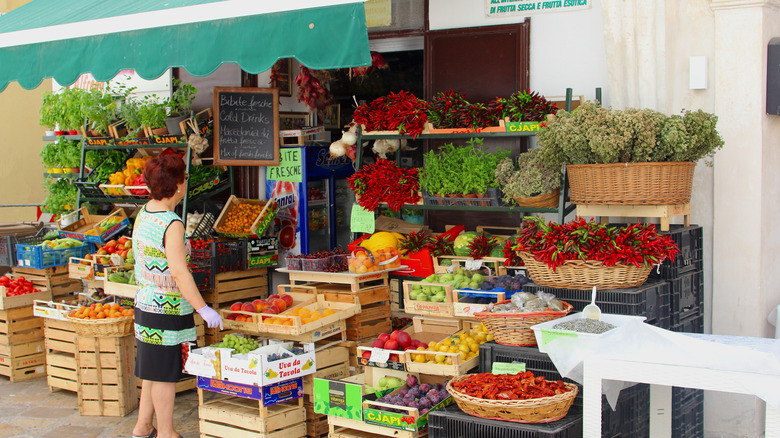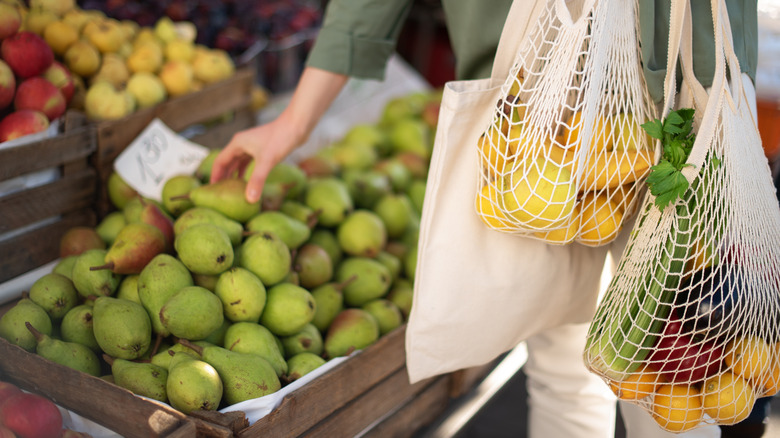14 Differences Between American And European Supermarkets
A huge part of the appeal of traveling is experiencing other cultures, especially through their cuisine. From street food to restaurant meals, dining options are plentiful. Yet in many countries, supermarkets are the source of the average daily diet. While you'd think a place that sells food would be similar around the world apart from the actual selection of products, there are far more differences that come up when you take a closer look.
The distinctions between European and American supermarkets are vast, although you will still find some overlapping features. That being said, within Europe there are just as many differences, and it can be hard to find many parallels between, say, a Danish supermarket and one in Spain. Nonetheless, there are a number of ways that European grocery stores stand apart from the ones we are used to on this side of the Atlantic. Let's zoom in to identify each of them — and how they affect the overall shopping experience.
Prices vary significantly depending on the product and European country
It's no secret that grocery prices are on the rise, and different areas of the world will see variations in what items are soaring and which are still relatively stable. While the distinction is notable between the U.S. and Europe, it's worth pointing out that within the latter, each individual country sees its own share of fluctuations. Coastal areas experience different conditions compared with land-locked regions, and historical, economical, and cultural aspects all come into play.
That being said, some generalizations can be made regarding the comparison of U.S. and European groceries. An analysis by Commodity.com assessed a number of grocery staples to see whether they were above or below average American prices. Certain European prices — in particular, in Scandinavian countries and Switzerland — were greater than on home turf.
However, overall the U.S. rates 12th worldwide for the most expensive groceries. Interestingly, when the figures are considered as a proportion of income, Quartz reports that American consumers spend less than other places. Additionally, many agricultural products are grown in surrounding states, which reduces costs of transportation. Regardless, chances are that the market will continue to experience significant change as the global economy evolves.
Customers need to weigh produce in Europe
If you're used to filling bags with fruits and vegetables or grabbing a pre-packaged assortment and heading for the checkout line, it's not such a direct path to the cash in Europe. Typically, customers must weigh their own produce on an electric scale using the item's code or selecting it by image. The machine spits out a printed sticker with the details of your purchase, including a barcode. And voilà — the cashier can simply scan the produce instead of typing in the code and weighing it themselves.
Within Europe, certain supermarket chains are known for being the exception, and not all countries follow this method. Nonetheless, it is widespread enough to be a surprise for most American tourists. According to The German Way and Italy Explained, it's very common for shoppers to weigh their own produce in the respective countries. Similarly, Paris Perfect and Almuñécar Info highlight the fact that in France and Spain, the practice varies depending on the store. When in doubt, have a look at what everyone else is doing. Although it gives the customer an extra task while they shop, the fact that it speeds up the checkout process is definitely a bonus.
American supermarkets tend to carry more international items
The U.S. prides itself on having access to more products — both regional and international — than you would be able to consume in several lifetimes. That's certainly the case when it comes to food, and American grocery stores are brimming with possibilities that span the globe, as confirmed by a consumer research report by the Private Labels Manufacturers Association (PLMA).
Walk into an average European supermarket and you'll likely have a different experience. Comparatively, the number of local products and foods tends to be greater than those from other cultures. With traditional regional specialties, you'll be harder pressed to find global delicacies in the average store. Unlike places like NYC where every street corner seems to house a different type of cuisine, you might have to do some digging if you're in smaller cities in Europe.
Meanwhile, if you're feeling homesick for your favorite ingredients, keep an eye out for the American aisle in grocery stores overseas. Per a compilation of photos by Insider, American food consists of extra large containers, marshmallow fluff, Jell-O, Twinkies, and other sickly sweet delights.
European cheese selections are often more affordable and varied
European cheese is often viewed as a gold standard. It's not only a matter of opinion; on a global scale, the European cheese market is at the top, according to an analysis by Prophecy Market Insight. Producers even receive government subsidies adding up to over $1 billion, further supporting the market (via The Guardian).
With timeless traditions and recipes spanning millenia, it's no wonder we get giddy at the sight of a cheese counter overseas. Expat blogs like Dispatches Europe recount the glees of buying delicious cheese at laughable prices, while Reddit threads ponder the high prices in the U.S. And while that comparison is still fairly accurate, the current economy is experiencing plenty of variability, and the cheese market is no exception.
In fact, according to Bloomberg, due to a chain reaction leading to milk shortages in The Netherlands, the country has been buying American processed cheese to fuel its supplies. Nonetheless, the relative quantity is still low, with only about 2,000 metric tons from the U.S. compared to the overall production of 10 million metric tons. Although prices are predicted to continue increasing (per IndexBox), consumers can rest assured that European cheese offerings are not about to disappear.
The cost of meat in the U.S. is lower (but so is the quality, in many instances)
While low costs are typically a desirable advantage, they can also be related to the quality of production standards. An article published in Open Philanthropy Project looks at the less commonly asked question of why meat is so cheap in the U.S. The author considers factors such as government subsidies amidst a lack of regulations for eliminating potential negative outcomes for people (from factory waste) and improving animal welfare.
A 2017 report by Caterwings assessing meat prices in 50 countries found that Americans pay about half of the cost of most European countries, with the exception of Switzerland, which soars to the top (via Eater). The study noted the fact that the U.S. produces most types of meat locally, reducing transportation costs and keeping prices low.
Although average meat prices may be more expensive in European supermarkets, it's worth noting that the EU's standards for domestic and imported meat are very high. If a greater cost helps guarantee the excellent quality of a product, it's a fair payoff.
European junk food and candy contains fewer additives
Food products vary across international borders, and what's sold in one place can be impossible — or illegal — to find elsewhere. As it turns out, Europeans place a lot of weight on the quality of their food items, including the historical and geographical specifications that make some of them unique.
When it comes to additives, the European Union has stricter standards of control than the U.S. Per a 2004 research by Ecologic, Europe's measures were designed as precautions against possible harm. Meanwhile, in the States, the focus is on the probability of a bad outcome actually occurring (via Everyday Health). This policy has undoubtedly been relevant to processed foods. Per Ensia, various chemicals are banned in Europe while being allowed in the U.S. due to the USDA's less rigid restrictions.
Everyday Health lists dozens of food additives banned in Europe that are still well and present on the American market. For example, if you're wondering why the red candy you're eating on the other side of the Atlantic isn't as vivid as you're used to, the absence of color dye red no. 40 explains it. Various other additives that sound like the kind of chemicals you might not want in your food have been categorically eliminated in Europe.
Nutritious and sustainable ingredients are more accessible in European supermarkets
Many factors influence the health of a population, and there's no denying that diet is one of them. According to Food Digital, a number of European supermarket chains are even willing to lend a hand in improving healthy food choices. With reduced prices for plant-based products, mobile apps to help track your shopping list (with built-in discounts for healthy picks), and methods for reducing waste, these initiatives are changing the way consumers in Europe shop.
Meanwhile, Food Digital found very limited resources of the kind on the American front. Instead, Peter Cooke from Radio Institute, a non-profit organisation aimed at sustainable retail food choices, explains that U.S. retailers prioritize consumer choices and profit rather than nutrition or sustainability.
With an environment that fosters harmony between food options, wellness, and ecological balance, it's no surprise that these principles are transferred to the consumer. According to a 2018 survey of European shopper insights by Information Resources, Inc. market research company, 70% of consumers are concerned with making ethical, sustainable, and local grocery purchases.
Smaller kitchens mean European consumers don't buy in bulk
When it comes to grocery shopping, more factors are involved than you might initially think. From the source to consumers' homes, a number of elements are at play — including the way kitchens and appliances are designed. The average population density in Europe is more than double that of the United States (per World Atlas), which is immediately noticeable in the respective housing conditions. The Atlantic featured an article discussing the comparatively large size of American houses, and this extends to kitchens.
With a small kitchen comes a small refrigerator, and in turn, the necessity to purchase food regularly, but in low quantities (via Wilshire). Unlike weekly grocery outings to load up your double-doored refrigerator, Europeans tend to favor the practice of buying supplies for the same or the next day. Not only does this custom add a ritualistic aspect to daily food prep, but it also reduces food waste, as highlighted by The Los Angeles Times. Furthermore, you'll consume ingredients and produce at their freshest, instead of resigning yourself to eating half a bag of limp carrots.
European eggs and milk aren't always refrigerated
If you grew up storing your eggs and milk in the fridge, you're sure to be perplexed when you see the two stacked on room temperature shelves in a European supermarket. Before you look for the closest food safety authority, it's actually totally fine. According to BBC, a number of European countries (as well as many tropical ones) opt for shelf-stable milk that goes through high heat treatment (double the temperature of regular pasteurization), essentially sterilizing the product. It's not quite fresh cow's milk from the farm (nor is the taste), but it sure saves a lot of money and space on refrigerated shelves.
Similarly, egg cartons in European supermarkets are rarely found in refrigerated sections. In an attempt to offer customers eggs with extra clean salmonella-free shells, the U.S. basically power washes its eggs, inadvertently removing a thin outer layer that is meant to protect the center from bacteria (via The Healthy). Consequently, American eggs need to be kept at cool temperatures to prevent the proliferation of bacteria, whereas the natural barrier is kept intact in Europe.
In fact, as per a 2008 report in the Official Journal of the European Union, it is illegal to eliminate the cuticle by intensely washing eggs. Instead, the European Commission vaccinates poultry flocks against salmonella to get to the source of the issue. Bakers will recognize this as a bonus: There's no need to remember to bring your eggs to room temperature.
Store hours are often more limited in Europe
Shopping for what you need at any hour of the day is a benefit of living in metropolitan cities in the U.S. And if your local supermarket isn't open, Bloomberg reports that around 90% of the country's convenience stores are open 24 hours a day for last-minute staples like eggs, bread, and milk. While some European capitals offer similar services, shopping hours are typically far more restricted.
There's no shortage of variation among European countries, so it's worth investigating the specifics. If you're visiting from the U.S., you might find yourself short of supplies with nowhere to go if you haven't planned ahead. For example, in hot countries like Italy and Spain, stores often operate on split schedules and close after lunch (via The Los Angeles Times). Meanwhile, in Germany, you'll be hardpressed to find a supermarket that's open on a Sunday outside of certain major cities (via The German Way).
The Sunday restriction isn't limited to Germany, and a 2015 study by the Centre for Economic Performance sought to determine the impact of making schedules more flexible in 30 countries. Ultimately, the economic consequences appeared favorable. However, there's a lot to be said about the notion of having a day of rest, whether or not it is for religious purposes. Culture and lifestyle will dictate much of the logistics, so be sure to do your research if you're planning on picking up groceries on your next European adventure.
Products vary in accordance with dietary differences between the two continents
Given the cultural differences in cuisines as well as access to ingredients, it goes without saying that supermarkets in Europe and the U.S. stock a diverse assortment of items. According to a 2019 study published in Nutrients, the average American diet is concerningly high in ultra-processed foods which are loaded with sodium, sugar, and fat. While packaged foods can be convenient supermarket purchases for on-the-go snacks and quick meals, there is a fine line between practical and preoccupying.
It's not to say that Europeans don't consume ultra-processed foods, but the rates are lower and the items tend to be from bakeries or soft drinks, as reported in the European Journal of Nutrition in 2021. Nonetheless, habits differ overseas and real wholesome food is often the focus, as psychology professor Charlotte Makey notes following a trip to Europe (via U.S. News).
With a greater cultural weight on the history and tradition surrounding meals, food goes beyond simply satisfying a craving. It is a way to communicate a story of a place, as evidenced in countless European recipes famous the world over. Walk through the pasta section in an Italian grocery store, and there's no doubt what country you're in. A deli counter brimming with cheese and pâté? You must be in France. With unique specialties at every corner, Europe is undeniably a place to feast.
Supermarket carts are usually coin-operated in Europe
If you're used to grabbing a shopping cart as you walk into the supermarket, you'll have to slow down in Europe. Across the Atlantic, it's totally normal to have to insert a coin to release a cart. As international travelers discuss on Quora, the practice is not as widespread outside Europe, and in the U.S. you'll typically only see coin-operated carts at Aldi supermarkets. In fact, according to Willamette Week, this system is widely unsuccessful in the States.
Before you become indignant about the idea of paying for a shopping cart, it's worth noting that you'll get your money back — provided you return the cart to the designated area. Perhaps you're the type of person who diligently brings their grocery cart back where it belongs, no matter the inconvenience. However, many people are less benevolent and will simply abandon the wheeled carts all over the place. While an employee is typically in charge of tidying up the chaos, not only does it require more staff, but parked cars also risk being hit in the interim.
Europe has more small supermarkets per capita than the U.S.
It's no secret that the U.S. loves its big box stores, whether they are stocking groceries or auto parts (via Stacker). And sure, with more physical surface area in the country, it's totally feasible to fill up the space with huge shops. In comparison, European countries and cities are generally more compact and densely populated, limiting the size of retailers.
A 2014 research published by the KTH Royal Institute of Technology in Stockholm, Sweden, assessed eco-friendly supermarkets and compared the sizes of these establishments in various countries. Unsurprisingly, while the U.S. has a greater ratio of large supermarkets to its population, most European countries surveyed are home to far more small shops per million inhabitants.
A survey by YPulse further confirmed these differences, finding that American shoppers tend to prefer big box stores and shopping online, while Europeans opt for smaller shops and farmer markets. Again, it makes perfect sense when considering average shopping habits; it's easier to pop into a small store and pick up the supplies you need for the day than to park at a large superstore and make your way through mazes of aisles to pick up a few items.
Paying for plastic bags has been the norm in Europe for years
You might feel like you're doing your part by bringing reusable bags to the grocery store, but in Europe, the ecological trend has been common for years. Though every country has its own specifications, the EU passed a mandate in 2015 to reduce the consumption of single-use plastic bags.
Given the wide reach of the member countries, it goes without saying that volumes of use vary depending on the region. For example, many places including England, Ireland, Spain, and Portugal impose fees for plastic bags in order to motivate consumers to bring their own. Other methods such as designing compostable bags are being introduced throughout Europe, with an aim to improve sustainability.
In the U.S., similar environmental endeavors are beginning to take effect, and as of 2021, eight states ban single-use plastics (via National Conference of State Legislatures). It's especially feasible to bring your own bags if you're purchasing smaller quantities at a time, as is often the case with European shopping customs. Even if your state isn't on board with these regulations yet, it's worth getting in the habit of bringing your own bags to reduce single-use plastic consumption.
